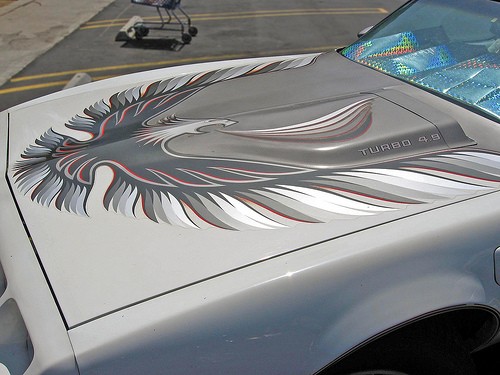The 1980 Pontiac Firebird Trans Am Turbo arrived shrouded in controversy and misconceptions. While its styling evoked the tail end of the disco era with bold pronouncements of performance, its engine, the first turbocharged powerplant from Pontiac, often faced criticism. This marked a pivotal moment, both celebrating a lineage of unique Pontiac engines while also signaling its twilight. This is the story of the often misunderstood and sometimes overlooked 1980 Pontiac Firebird Trans Am Turbo.
The Pontiac Strato-Streak Legacy
In an era where corporate giants like General Motors reigned supreme, individual divisions like Pontiac retained a remarkable degree of autonomy, especially in engine design. Until the late 1970s, Pontiac, Chevrolet, Buick, and Oldsmobile largely developed their own distinct engines. This independence, coupled with GM’s internal displacement limits based on car size, led to a fascinating proliferation of engines with similar displacements but unique architectures. By 1969, each of these divisions boasted its own 350 cubic inch engine, showcasing both GM’s vast resources and a certain internal competition.
Pontiac’s engine heritage was largely defined by its “Strato-Streak” V8. Introduced in 1955, this engine replaced Pontiac’s older flathead designs and became the cornerstone of Pontiac performance for decades. While sharing some design elements with the Chevrolet small-block, the Strato-Streak was larger, heavier, and possessed greater potential for expansion.
Expand it did, growing from 287 cubic inches to a massive 455 cubic inches by 1970. Throughout its life, the Strato-Streak powered a diverse range of Pontiac models, from the fuel-injected Bonneville, which heralded Pontiac’s move away from its stodgy image, to the high-performance 421 Super Duty versions that dominated drag strips and NASCAR circuits. Perhaps most famously, the 389 cubic inch variant cemented the legendary status of the Pontiac GTO, the original muscle car.
Despite its robust construction and power potential, the Pontiac V8, especially in smaller displacements like the 350, was heavier than competitors such as Chevrolet and Ford counterparts. This added weight negatively impacted weight distribution and fuel economy, becoming a growing concern as the automotive landscape shifted.
The Emergence of the Pontiac 301 and 265
The mid-1970s brought a seismic shift in automotive priorities. The Clean Air Act of 1970 and the subsequent Corporate Average Fuel Economy (CAFE) standards in 1975 forced automakers to prioritize fuel efficiency and emissions reduction. These regulations favored smaller displacement engines, pushing manufacturers to rethink their traditional reliance on large V8s.
Pontiac, like other divisions, responded by initiating a rapid development program for more fuel-efficient engines. While they had previously experimented with an innovative overhead-cam six, by the mid-70s their engine lineup consisted of a Chevrolet-sourced straight-six and their aging V8 in various displacements. The six was underpowered, and the 350 V8 was becoming too thirsty for the changing market.
As a temporary measure, Pontiac adopted Oldsmobile’s 260 cubic inch V8 in 1975. Buick’s V6 replaced the Chevrolet six in larger models by 1977. However, Pontiac desired its own smaller V8. Resource constraints due to new safety regulations prevented a completely clean-sheet design. Instead, Pontiac engineers turned to the existing 350 V8, seeking ways to downsize and modernize it.
Interestingly, Pontiac had explored a smaller version of the 350 in the late 1960s for racing: the 303 cubic inch Ram Air V engine. This project, aimed at SCCA Trans Am racing, provided valuable experience in re-engineering the Pontiac V8. While the Ram Air 303 was performance-focused and produced in limited numbers, it informed the development of a new, fuel-conscious V8.
The new engine, while thoroughly re-engineered like the 303, prioritized fuel economy and emissions over outright power. It featured thinner castings, lighter components, and redesigned ports, significantly reducing weight – a substantial 136 pounds lighter than the 350. This new engine, with a 302 cubic inch displacement (identical to Ford’s 302), was marketed as the 301 to avoid any perception of using a Ford design.
The Pontiac 301 V8 debuted in 1977, replacing the Oldsmobile 260 as the standard V8 in many Pontiac models. Initially producing a modest 135 horsepower, it was later offered in a four-barrel version with 150 horsepower. In 1980, a further downsized 265 cubic inch variant was introduced for increased fuel economy, producing only 120 horsepower. The 301 remained available, but the writing was on the wall – smaller, more efficient engines were the future.
Smokey and the Bandit’s Firebird Fame
The Pontiac Firebird, sharing the F-body platform with the Chevrolet Camaro, was among the models to receive the 301 and 265 engines. Introduced in 1967, the Firebird underwent a major redesign in 1970, adopting a sleek, European-inspired body penned by designers Jack Humbert and Bill Porter.
The second-generation Firebird retained the mechanical underpinnings of its predecessor but boasted stunning new aesthetics. While base models offered a Chevrolet six or a 350 Pontiac V8, the Firebird range, particularly the Trans Am, offered a spectrum of performance and visual flair. The Trans Am, introduced in 1969, became the performance flagship, featuring a standard 400 cubic inch engine and aggressive styling cues.
Despite its sporty looks, the Firebird’s arrival coincided with a downturn in pony car sales. Near cancellation after 1972 was averted, and by the mid-1970s, sales rebounded dramatically, largely fueled by the Trans Am’s starring role in the blockbuster movie Smokey and the Bandit (1977). Firebird sales soared, with Trans Ams accounting for roughly half of the 1978 total of 187,285 units.
The Firebird’s iconic 1970½ body style endured with minor updates through 1981. Despite federally mandated 5 mph bumpers, the Firebird maintained its integrated design, avoiding the ungainly “battering ram” look of many contemporary cars. The “screaming chicken” hood decal, introduced in 1973, became a defining, if sometimes polarizing, feature.
However, under the hood, the performance narrative had shifted. While early second-generation Firebirds, especially the rare Super Duty 455 models, represented the last bastion of true muscle car power, emissions regulations and reduced compression ratios tamed their performance by the mid-1970s.
The 455 V8, still available until 1976, produced a mere 200 horsepower in its final iteration. The 400 V8, then the top option, offered only 180 horsepower, though later versions and the optional W72 engine brought that figure up to 220 horsepower in non-California markets. California-bound cars were limited to the Oldsmobile 403 V8 due to stricter emissions standards.
Despite weighing over 3,600 pounds, a well-equipped Trans Am still delivered respectable performance in the late 1970s. However, compared to the muscle car titans of 1970, the Firebird’s performance was considerably milder. Nevertheless, strong sales indicated that buyers in the disco era prioritized image as much as raw power. The Trans Am, however, was recognized as a surprisingly capable handling car for its time.
The Pontiac 301 Turbo Arrives
Buick’s successful foray into turbocharging in the late 1970s, with a turbocharged V6 for the Indianapolis 500 pace car and subsequent production models, provided a potential path forward for performance and efficiency. Turbocharging, once used sparingly by GM in the early 1960s, was being revisited as a means to extract V8-like power from smaller, more fuel-efficient engines.
Pontiac experimented with turbocharging its new “Iron Duke” four-cylinder engine and rumors circulated about Pontiac adopting Buick’s turbo V6. Ultimately, Pontiac decided to develop a turbocharged version of its 301 V8.
Interestingly, the project originated as a student endeavor at the General Motors Institute (GMI). Engineering students, under Professor Jim Lyons, developed a low-emissions turbocharged conversion of a Firebird 350 for a competition. Lyons presented this student project to Pontiac’s chief engine engineer Leo Hilke, sparking the idea for a production turbocharged 301.
Since the 350 V8 was no longer in production, Pontiac adapted the turbocharger to the 301. Utilizing a single Garrett AiResearch TBO-305 draw-through turbocharger with a maximum boost of 9 psi, the 301 Turbo, or 301T, was born for the 1980 model year. To handle the added stress of turbocharging, Pontiac engineers strengthened the 301 with a higher-capacity oil pump and reinforced internal components, making it slightly heavier than the standard 301. The compression ratio was lowered to 7.6:1 to prevent detonation with regular unleaded fuel. A modified Rochester Quadrajet carburetor provided under-boost enrichment, and a Delco Electronic Spark unit managed timing. A bulged hood was necessary to accommodate the turbocharger.
The 301T replaced both the Pontiac 400 and Oldsmobile 403 in 1980, boasting a nominal 210 horsepower and 345 lb-ft of torque – a significant increase over the naturally aspirated 301. The turbo package (RPO LU8) was available only with an automatic transmission and a 3.08 axle ratio, offered for a reasonable $350 on Trans Ams and $530 on Formulas. While meeting federal emissions, the 301 Turbo was not available in California, though some were assembled there.
The 1980 Pontiac Firebird Trans Am Turbo in Practice
Despite its evocative name, the 1980 Firebird Trans Am Turbo’s performance was more nuanced than outright blistering. Initial tests by Car and Driver and Motor Trend in late 1979 recorded 0-60 mph times around 8 seconds and quarter-mile times in the mid-16s, with a top speed of 116 mph. While respectable for 1980, this was slower than earlier 400 cubic inch Firebirds. Furthermore, inconsistent test results and reports of pre-ignition raised concerns. A Camaro Z28 with a manual transmission could even outperform the automatic-only Trans Am Turbo despite the Pontiac’s paper horsepower advantage.
However, the Trans Am Turbo offered a compelling value proposition. A well-equipped model could be purchased for under $10,000, significantly less than a Corvette, Datsun 280ZX Turbo, or Triumph TR8. Handling was considered improved due to reduced front-end weight, and optional four-wheel disc brakes provided excellent stopping power.
The ultimate expression of the Trans Am Turbo was the 1980 Indianapolis 500 Pace Car replica. Limited to 5,700 units, these replicas were essentially fully loaded Trans Ams with the turbo engine and every available option, including T-tops, air conditioning, limited-slip differential, white alloy wheels, and the WS6 handling package with four-wheel disc brakes. Finished exclusively in Cameo White with gray accents and a unique hood decal, the Pace Car commanded a hefty $11,194 price tag, compared to the $7,529 base price of a turbo Trans Am. Like the standard turbo model, the Pace Car was unavailable in California due to emissions non-compliance.
The Pace Car, while visually striking, represented the twilight of an era. The Firebird, despite its enduring style, was becoming less practical and more dated in terms of interior space and visibility. The 1979 energy crisis and economic downturn further impacted sales, with Firebird sales plummeting in 1980. Turbocharged models accounted for a small fraction of the total sales.
The second-generation Firebird returned for a final year in 1981. The 301T remained an option for non-California cars, now featuring electronic engine management and slightly reduced horsepower. A Daytona 500 Pace Car replica was also offered. However, overall Firebird sales continued to decline.
The End of Pontiac’s Engine Independence
The following year, a new, more aerodynamic Firebird debuted, famously becoming KITT in the Knight Rider TV series. However, the turbo 301 did not return, nor did the 301 engine itself. While turbocharging provided a brief reprieve for the Pontiac V8, GM made the strategic decision to standardize engines across most divisions, except Cadillac. Pontiac would continue producing the Iron Duke four-cylinder, but future Pontiac V8s would be Chevrolet-sourced.
This move towards “corporate” engines, while economically sound, further eroded the distinct identities of GM’s divisions. The differences between Chevrolet, Pontiac, Oldsmobile, and Buick became increasingly superficial, impacting GM’s market position and brand loyalty.
The 301 Turbo Trans Am has faced mixed opinions over the years. Often criticized for its performance and reliability, it hasn’t achieved the cult status of later Buick turbo models. However, it has its dedicated fans who argue it’s unfairly maligned and capable of respectable performance with proper care. More importantly, the 1980 Trans Am Turbo represents the last chapter of Pontiac’s independent engine development – the final Pontiac V8 and, arguably, the last truly distinctive Pontiac.
FIN

